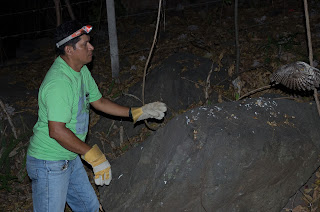There is an amazingly complex set of conflicts between people and wildlife, much more extensive and complex than anyone can appreciate. Humans impact wild animals in their natural environment in numerous ways, and for most wildlife, the impacts are negative. Birds may almost always be seen near areas of human activity, but several species of birds are not compatible with humans or with the birds that are compatible with humans and accompany them.
We feel gratified and awed, however, by the kindness shown by a family visiting the area and the happy ending for an owl. This family had noted an owl in distress in standing water, near the lake, and upon our suggestion, brought us the poor bird. It was obviously in severe distress, completely defenseless, and at risk of getting attacked by pet cats in a yard. The owl appeared to be in shock. We took the owl, wrapped in an old shirt, and placed it in a cage, and waited. We gave it a small amount of water, and then left it alone, warm inside a cocoon to recover from the shock it was experiencing and guarded from the distractions of daytime in a draped cage.
The owl was clearly an adult Pacific Screech-Owl (Megascops cooperi). This is perhaps the most common and definitely the most evident of the owl species in Laguna de Apoyo Nature Reserve, particularly because of their willingness to reside in areas inhabited by humans. We have had some positive experience with this species, so we felt confident that we could feed it and give it a chance to survive and return to the wild. In the worst of cases, we could give it a restful end in a quiet place, if it indeed would not survive.
 |
| The Pacific Screech-Owl is taken from the cage, prepared to return to the wild. Photo Lars Sanger. |
Within a few hours, the owl had recovered considerable energy. By the end of the day, it was sitting on a perch, and showing a much better posture. Then, an egg appeared under the perch! The egg had cracked in the fall, but nonetheless, it helped explain the distress of the poor animal. Encouraged by the event and the improvement of the spirits and energy of the bird, we gave it lots of food, in the form of Asian house geckos (Hemidactylus frenatus), an invasive species which abounds around artificial lights in the area. After two evenings and days of comfort and food, it had not produced another egg yet, but it (or rather, she) was calling in the evening and receiving a response from the trees above. Could it be her mate?
 |
| Pablo Somarriba prepares to release the Pacific Screech-Owl. Photo Lars Sanger. |
A recent evening, Pablo removed her from her cage, took her to a nearby secluded area, and released her. She did not hesitate. Within a fraction of a second, she had flown. She landed in a nearby tree, where she perched to assess her new freedom and examine the surroundings.
 |
| The Pacific Screech-Owl returns to the wild. Photo Lars Sanger. |
These issues are grave in the context of the Laguna de Apoyo Nature Reserve, where human activity is intense. It is one of the most visited protected areas in Nicaragua, with some 100 residences and hotels along the shores of the lake.
 |
| Flight to freedom! Photo Lars Sanger. |
Our member of the neighborhood owl family is again in the wild, where she will, hopefully, reintegrate and go on to reproduce. She was saved from a sure death by dogs in a yard, and now, she has another opportunity to live and die in the wild as she was destined.
We can appreciate the Pacific Screech-Owl in Laguna de Apoyo Nature Reserve almost any evening, by following the calls made within a family group. The members of a group frequently interchange a pleasant, bouncy call each evening. Occasionally during daytime, they can be spotted roosting in trees, sometimes just overhead of us in our daily activities. They are occasionally spotted during birdwatching excursions as well, because they may be roosting in plain view. This is one of the owls most tolerant of the presence of humans, so they are more easily found than most other owl species in the inhabited areas of the reserve.
 |
| The Pacific Screech-Owl is now in the wild again! Photo Lars Sanger. |
 |
| Click on the escudo to contact us! |

No comments:
Post a Comment